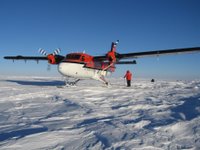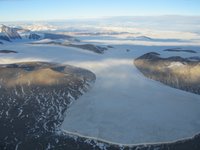Measurements over the Antarctic Plateau

 Sorry for the late reply. The network has been down on station for the past two nights. It was out for almost 30 hours, just came back on line this afternoon.
A few of you have sent in some questions, so I will do my best to answer them later tonight.
On Friday morning the Twin Otter flew up to the Antarctic Plateau. I gave my camera to our pilots (Chuck and Rob) and they snapped a bunch of photos along the way. When we stopped to refuel and Doug took the opportunity to make some measurements of the production of nitric oxide (NO) in the snowpack.
Sorry for the late reply. The network has been down on station for the past two nights. It was out for almost 30 hours, just came back on line this afternoon.
A few of you have sent in some questions, so I will do my best to answer them later tonight.
On Friday morning the Twin Otter flew up to the Antarctic Plateau. I gave my camera to our pilots (Chuck and Rob) and they snapped a bunch of photos along the way. When we stopped to refuel and Doug took the opportunity to make some measurements of the production of nitric oxide (NO) in the snowpack.
 Things went well on this flight, but it was below - 30 C on the plateau, too cold for the fuel pump to start. So Rob had to used some compressed air to push the fuel out of the drums and into the aircraft fuel tank. This took a long time (over an hour) and everyone (and all the instruments) got very cold. Based on these measurements we are starting to think that we might have a leak in the NO instrument. So we are going to delay the 4th science flight until we can be sure that the NO instrument is working.
Things went well on this flight, but it was below - 30 C on the plateau, too cold for the fuel pump to start. So Rob had to used some compressed air to push the fuel out of the drums and into the aircraft fuel tank. This took a long time (over an hour) and everyone (and all the instruments) got very cold. Based on these measurements we are starting to think that we might have a leak in the NO instrument. So we are going to delay the 4th science flight until we can be sure that the NO instrument is working.
 Today (Monday), Dave Tanner flew to the South Pole to retrieve the NO instrument that we left there a couple of weeks ago. Since we know this instrument works, we are thinking that we will fly with this instrument on the Twin Otter for the next few weeks, and then return it to the Pole where it can make measurements for the rest of the year. Dave left on the 7:15 AM flight to the pole and is scheduled to return at 1:00 AM tomorrow morning. While my spectroradiometer has been working very well so far this trip, it did not like the -30 C temperatures when the Twin Otter was stranded on the plateau for an hour on Friday. It was "frozen up" (i.e., too cold for brass and steel metal gears to move) for about 20 minutes after fueling. After it finally warmed up enough to start, it was not really working so well. So I spent some time this morning checking it out and I am pleased to report it working well right now. But I am keeping my fingers crossed that we do not have any permanent damage to the gears.
Today (Monday), Dave Tanner flew to the South Pole to retrieve the NO instrument that we left there a couple of weeks ago. Since we know this instrument works, we are thinking that we will fly with this instrument on the Twin Otter for the next few weeks, and then return it to the Pole where it can make measurements for the rest of the year. Dave left on the 7:15 AM flight to the pole and is scheduled to return at 1:00 AM tomorrow morning. While my spectroradiometer has been working very well so far this trip, it did not like the -30 C temperatures when the Twin Otter was stranded on the plateau for an hour on Friday. It was "frozen up" (i.e., too cold for brass and steel metal gears to move) for about 20 minutes after fueling. After it finally warmed up enough to start, it was not really working so well. So I spent some time this morning checking it out and I am pleased to report it working well right now. But I am keeping my fingers crossed that we do not have any permanent damage to the gears.
 Above is a photo of the Antarctic Plateau from the air. This is what it looks like as far as the eye can see. When I went to the South Pole (5 years ago) it looked just like this. This is very similar to what it looks like on the top of the Greenland Icesheet as well. To the right is a photo of some ripples in the ice. I don't know much about this, but I thought it was interesting how regularly spaced these are. I do not know if these are crevasses, or the "mega-dunes" that I have heard about. I'll ask around and see if I can find out.
Above is a photo of the Antarctic Plateau from the air. This is what it looks like as far as the eye can see. When I went to the South Pole (5 years ago) it looked just like this. This is very similar to what it looks like on the top of the Greenland Icesheet as well. To the right is a photo of some ripples in the ice. I don't know much about this, but I thought it was interesting how regularly spaced these are. I do not know if these are crevasses, or the "mega-dunes" that I have heard about. I'll ask around and see if I can find out.

<< Home